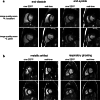Comparison of cardiac volumetry using real-time MRI during free-breathing with standard cine MRI during breath-hold in children
- PMID: 35353211
- PMCID: PMC9271116
- DOI: 10.1007/s00247-022-05327-5
Comparison of cardiac volumetry using real-time MRI during free-breathing with standard cine MRI during breath-hold in children
Abstract
Background: Cardiac real-time magnetic resonance imaging (RT-MRI) provides high-quality images even during free-breathing. Difficulties in post-processing impede its use in clinical routine.
Objective: To demonstrate the feasibility of quantitative analysis of cardiac free-breathing RT-MRI and to compare image quality and volumetry during free-breathing RT-MRI in pediatric patients to standard breath-hold cine MRI.
Materials and methods: Pediatric patients (n = 22) received cardiac RT-MRI volumetry during free breathing (1.5 T; short axis; 30 frames per s) in addition to standard breath-hold cine imaging in end-expiration. Real-time images were binned retrospectively based on electrocardiography and respiratory bellows. Image quality and volumetry were compared using the European Cardiovascular Magnetic Resonance registry score, structure visibility rating, linear regression and Bland-Altman analyses.
Results: Additional time for binning of real-time images was 2 min. For both techniques, image quality was rated good to excellent. RT-MRI was significantly more robust against artifacts (P < 0.01). Linear regression revealed good correlations for the ventricular volumes. Bland-Altman plots showed a good limit of agreement (LoA) for end-diastolic volume (left ventricle [LV]: LoA -0.1 ± 2.7 ml/m2, right ventricle [RV]: LoA -1.9 ± 3.4 ml/m2), end-systolic volume (LV: LoA 0.4 ± 1.9 ml/m2, RV: LoA 0.6 ± 2.0 ml/m2), stroke volume (LV: LoA -0.5 ± 2.3 ml/m2, RV: LoA -2.6 ± 3.3 ml/m2) and ejection fraction (LV: LoA -0.5 ± 1.6%, RV: LoA -2.1 ± 2.8%).
Conclusion: Compared to standard cine MRI with breath hold, RT-MRI during free breathing with retrospective respiratory binning offers good image quality, reduced image artifacts enabling fast quantitative evaluations of ventricular volumes in clinical practice under physiological conditions.
Keywords: Children; Computer-assisted; Heart; Image processing; Magnetic resonance imaging; Respiration; Volumetry.
© 2022. The Author(s).
Conflict of interest statement
Jens Frahm and Dirk Voit are co-inventors of a patent and software describing the real-time MRI technique used here. The other authors declare no conflicts of interest.
Figures





Similar articles
-
Breath-hold and free-breathing quantitative assessment of biventricular volume and function using compressed SENSE: a clinical validation in children and young adults.J Cardiovasc Magn Reson. 2020 Jul 27;22(1):54. doi: 10.1186/s12968-020-00642-y. J Cardiovasc Magn Reson. 2020. PMID: 32713347 Free PMC article.
-
Compressed sensing real-time cine cardiovascular magnetic resonance: accurate assessment of left ventricular function in a single-breath-hold.J Cardiovasc Magn Reson. 2016 Aug 24;18(1):50. doi: 10.1186/s12968-016-0271-0. J Cardiovasc Magn Reson. 2016. PMID: 27553656 Free PMC article.
-
Compressed SENSE single-breath-hold and free-breathing cine imaging for accelerated clinical evaluation of the left ventricle.Clin Radiol. 2019 Apr;74(4):325.e9-325.e17. doi: 10.1016/j.crad.2018.12.012. Epub 2019 Jan 25. Clin Radiol. 2019. PMID: 30686503
-
Detection of cardiovascular disease in elite athletes using cardiac magnetic resonance imaging.Rofo. 2013 Dec;185(12):1167-74. doi: 10.1055/s-0033-1350130. Epub 2013 Jul 29. Rofo. 2013. PMID: 23897528 Review.
-
Will MRI of gastrointestinal function parallel the clinical success of cine cardiac MRI?Br J Radiol. 2019 Jan;92(1093):20180433. doi: 10.1259/bjr.20180433. Epub 2018 Oct 24. Br J Radiol. 2019. PMID: 30299989 Free PMC article. Review.
Cited by
-
Assessment of the cardiac output at rest and during exercise stress using real-time cardiovascular magnetic resonance imaging in HFpEF-patients.Int J Cardiovasc Imaging. 2024 Apr;40(4):853-862. doi: 10.1007/s10554-024-03054-6. Epub 2024 Jan 18. Int J Cardiovasc Imaging. 2024. PMID: 38236362 Free PMC article.
-
Accelerated cardiac magnetic resonance imaging using deep learning for volumetric assessment in children.Pediatr Radiol. 2024 Sep;54(10):1674-1685. doi: 10.1007/s00247-024-05978-6. Epub 2024 Jul 17. Pediatr Radiol. 2024. PMID: 39017676 Free PMC article.
-
First experience with real-time magnetic resonance imaging-based investigation of respiratory influence on cardiac function in pediatric congenital heart disease patients with chronic right ventricular volume overload.Pediatr Radiol. 2023 Dec;53(13):2608-2621. doi: 10.1007/s00247-023-05765-9. Epub 2023 Oct 5. Pediatr Radiol. 2023. PMID: 37794175 Free PMC article.
-
Free-breathing, Highly Accelerated, Single-beat, Multisection Cardiac Cine MRI with Generative Artificial Intelligence.Radiol Cardiothorac Imaging. 2025 Apr;7(2):e240272. doi: 10.1148/ryct.240272. Radiol Cardiothorac Imaging. 2025. PMID: 40178397
-
External Hardware and Sensors, for Improved MRI.J Magn Reson Imaging. 2023 Mar;57(3):690-705. doi: 10.1002/jmri.28472. Epub 2022 Nov 3. J Magn Reson Imaging. 2023. PMID: 36326548 Free PMC article. Review.
References
MeSH terms
LinkOut - more resources
Full Text Sources

